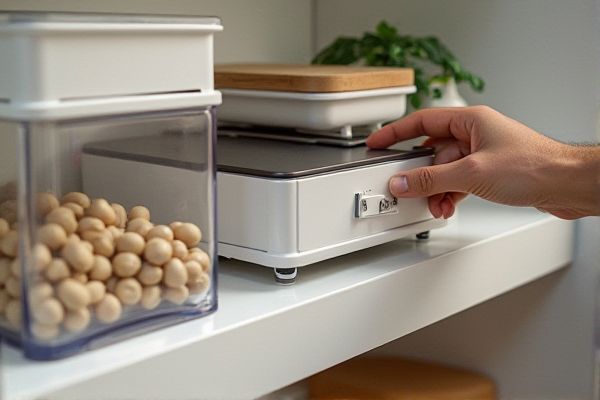
Magnetic containers offer the convenience of easy attachment to metal surfaces, saving space and providing quick access, while clip-on containers secure firmly to shelves or rods, ensuring stability during movement or vibrations. Discover which storage solution best fits Your needs by exploring their unique advantages and ideal applications in the full article.
Table of Comparison
| Feature | Magnetic Containers | Clip-On Containers |
|---|---|---|
| Attachment Method | Magnetic force for quick, tool-free attachment | Spring-loaded Clips for secure fastening |
| Ease of Use | Simple to attach/detach, ideal for rapid access | Requires manual clipping, more secure |
| Surface Compatibility | Works best on metal surfaces | Compatible with a variety of surfaces and edges |
| Holding Strength | Strong magnetic grip but may weaken with dust or debris | High mechanical hold, less affected by surface condition |
| Durability | Magnets may demagnetize over time | Clips are generally durable with less maintenance |
| Usage | Great for quick rearrangements and organization | Best for permanent or semi-permanent mounting |
| Cost | Typically moderate price due to magnetic materials | Usually lower cost, simpler construction |
Introduction to Magnetic and Clip-On Containers
Magnetic containers attach securely to metal surfaces using strong magnets, providing quick access and easy repositioning without tools. Clip-on containers fasten tightly to shelves or racks through durable clips, offering stable storage options that prevent slipping or falling. Both designs maximize space efficiency and organizational convenience in kitchens, workshops, and offices.
How Magnetic Containers Work
Magnetic containers function by embedding strong magnets within their walls or lids, allowing them to securely attach to ferromagnetic surfaces such as refrigerator doors or metal shelves. This magnetic adhesion provides easy access and space-saving storage without the need for clamps or clips, preventing slippage and ensuring stability. Unlike clip-on containers that rely on mechanical grip, magnetic containers utilize magnetic force for quick attachment and detachment, enhancing convenience and versatility in organizing kitchens or workspaces.
How Clip-On Containers Function
Clip-on containers function by securely attaching to the edges of surfaces using built-in clips that exert pressure to hold the container in place, ensuring stability without the need for adhesives or magnets. Their design allows easy installation and removal while maintaining a firm grip on a variety of materials such as glass, metal, or wood. This mechanical fastening method provides versatility for organizing spaces where magnetic surfaces are unavailable or impractical.
Material and Durability Comparison
Magnetic containers are typically made from high-strength stainless steel or aluminum alloys, providing excellent resistance to rust and corrosion, ensuring long-lasting durability. Clip-on containers often use lighter plastic or metal materials that may wear out or lose grip over time, reducing their lifespan and reliability. The superior material quality of magnetic containers enhances their durability in various environments, making them more suitable for heavy-duty storage needs.
Ease of Use and Accessibility
Magnetic containers offer effortless attachment and removal on metal surfaces, allowing quick access without fumbling with clips or latches. Clip-on containers may require more precise alignment and a firmer grip, potentially slowing down usage in busy environments. You can enhance your organization by choosing magnetic containers for seamless accessibility and ease of use.
Space-Saving Benefits
Magnetic containers offer superior space-saving benefits by securely attaching to metal surfaces like refrigerators or metal racks, freeing up valuable countertop and cabinet space. Clip-on containers require designated rails or edges, which may limit flexibility and reduce overall storage efficiency in smaller kitchens. Your organization efforts will be more effective with magnetic containers, maximizing available space and providing easy access to stored items.
Versatility and Storage Options
Magnetic containers offer versatile storage solutions by easily attaching to metal surfaces, saving counter space and allowing quick access to spices, tools, or supplies in your kitchen or workspace. Clip-on containers provide flexible attachment options to various edges or rails, making them ideal for customizable organization in cupboards, drawers, or shelves. Choose magnetic containers for streamlined vertical storage and clip-on containers for adaptable placement tailored to your specific needs.
Ideal Use Cases for Each Container Type
Magnetic containers are ideal for kitchen organization, easily attaching to metal surfaces like refrigerators or range hoods, perfect for storing spices, small tools, or office supplies within quick reach. Clip-on containers excel in versatile storage solutions, attaching securely to shelves, desks, or drawers, making them suitable for craft materials, stationery, or bathroom toiletries where wall mounting is impractical. Choosing the right container depends on the available attachment points and the need for portability or fixed storage in various environments.
Pros and Cons: Magnetic vs Clip-On Containers
Magnetic containers offer easy attachment and repositioning on metal surfaces, making them ideal for versatile storage solutions, but they may lose strength over time or damage delicate surfaces. Clip-on containers provide secure fastening to edges or shelves, ensuring stability in various environments, though they often require specific dimensions to fit properly and can be less flexible in placement. Both options present unique advantages and limitations depending on the intended use, surface compatibility, and storage needs.
Choosing the Right Container for Your Needs
Magnetic containers offer strong attachment to metal surfaces, ideal for quick access and space-saving organization in kitchens or workshops. Clip-on containers provide versatile portability, easily attaching to shelves, racks, or the edges of surfaces, making them suitable for flexible storage solutions. Your choice depends on whether you prioritize permanent stability or adaptable placement for your storage needs.
 homyna.com
homyna.com